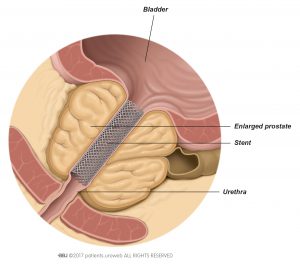Table of Contents
Prostate stents are used to keep the urethra open which improves the flow of urine. Stents are mainly recommended for men who are not fit for surgery but who are still able to empty the bladder on their own. They are used instead of an indwelling catheter.
When should I consider getting a stent?
Today, stents are not recommended as a permanent treatment option. You should consider stents only if you cannot tolerate anaesthesia which is needed for surgery.
How is the stent inserted?
The stent can be placed in the doctor’s office or a clinic under local anaesthesia. It is inserted into the urethra until the tip reaches the bladder (Fig. 1). The correct position is checked with an ultrasound or a cystoscope.
How to prepare for the procedure
Your doctor will advise you in detail how to prepare for the procedure. If you are taking any prescribed medication, discuss it with your doctor. You may need to stop taking it before the procedure.
After the procedure
How long will it take me to get back to my daily activities?
Usually, you can go back to your daily activities on the day of the procedure. There may be some blood in your urine and you may feel pain when you urinate. This can last up to several weeks.
You need to go back to your doctor or to the hospital right away if you:
- Develop a fever
- Are unable to urinate on your own
- Have heavy blood loss or pain


